My collection of Third Reich postkartes:
Nazi Rally (1933):

This is a commemorative postcard from 1933 featuring a nationalistic image of a party rally at the Brandenburg Gate in Berlin. Below the image are the words 'Deutschland, Deutschland uber alles!' or 'Germany, Germany above all!'' in English. It also lists the date of January 30th 1933 which was the date Hitler became chancellor of Germany after being appointed by President Paul von Hindenburg. In the top right of the card is the dual side portrait of Adolf Hitler and Paul von Hindenburg with a value of 6 Pfennig printed above them.
This particular example was postally used on the 24th of February 1934, sent from the village of Rossla and is addressed to Paul Berger in Halle. There is an lengthy message on the back of the postcard although I've only managed to determine so far that the author is writing to inform Mr Berger that he won't be able to accept an invitation due to the late notice he was afforded.
Hitler and Girls of the 'Band of German Maidens' BDM (1934):
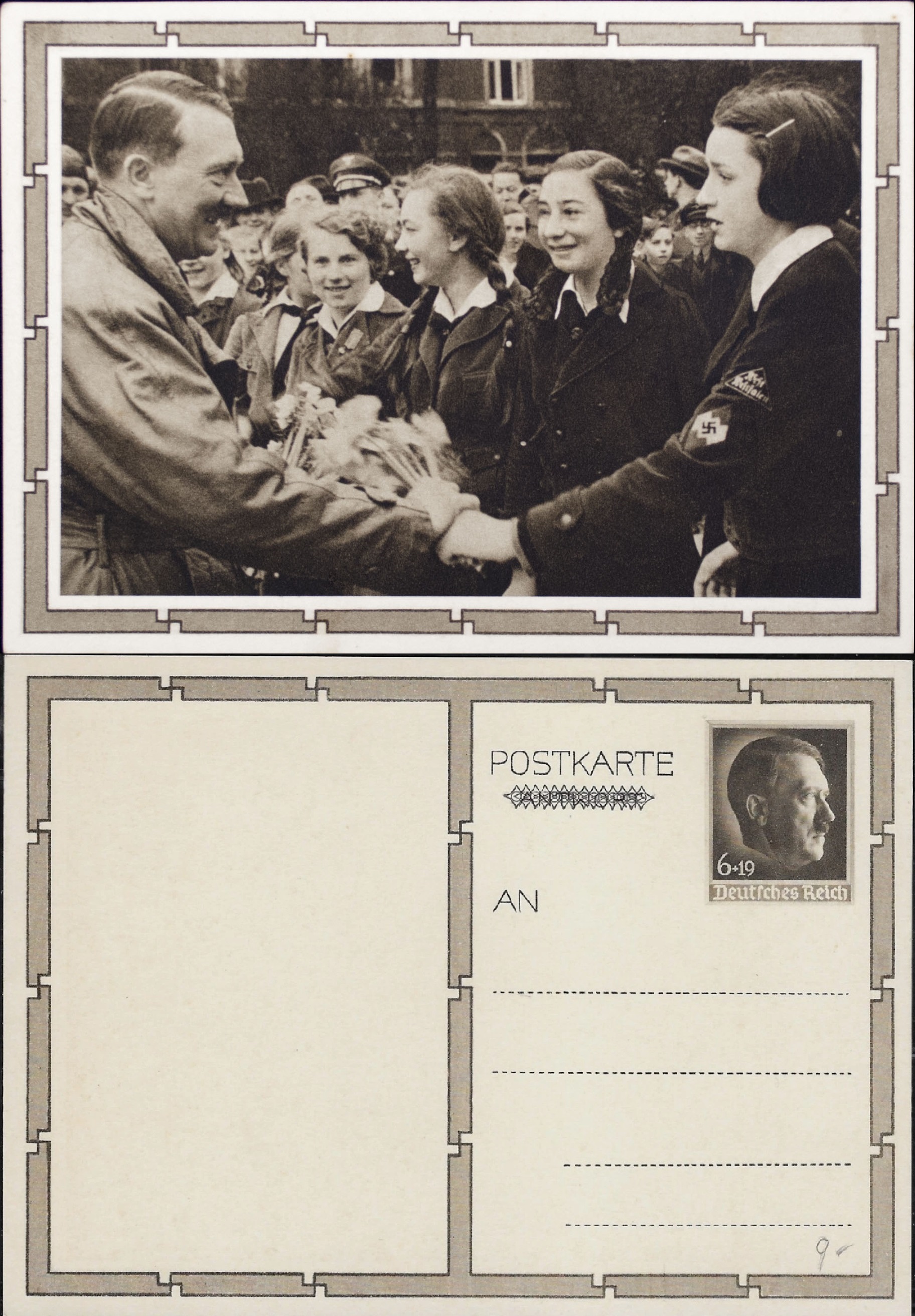
This unused postkarte features an image of Adolf Hitler greeting adoring members of the BDM. The female version of the Hitler Youth that went by both the 'Band of German Maidens' or 'The League of German Girls'. The original photograph featured on the postkarte was taken by Hitler's personal photographer and friend Heinrich Hoffman. In the top right corner is a Hitler head print featuring his side profile and a value of 6 + 19 Pfennig.
Annual Harvest Festival 'Erntedanktag' in Bueckeberg (1934):
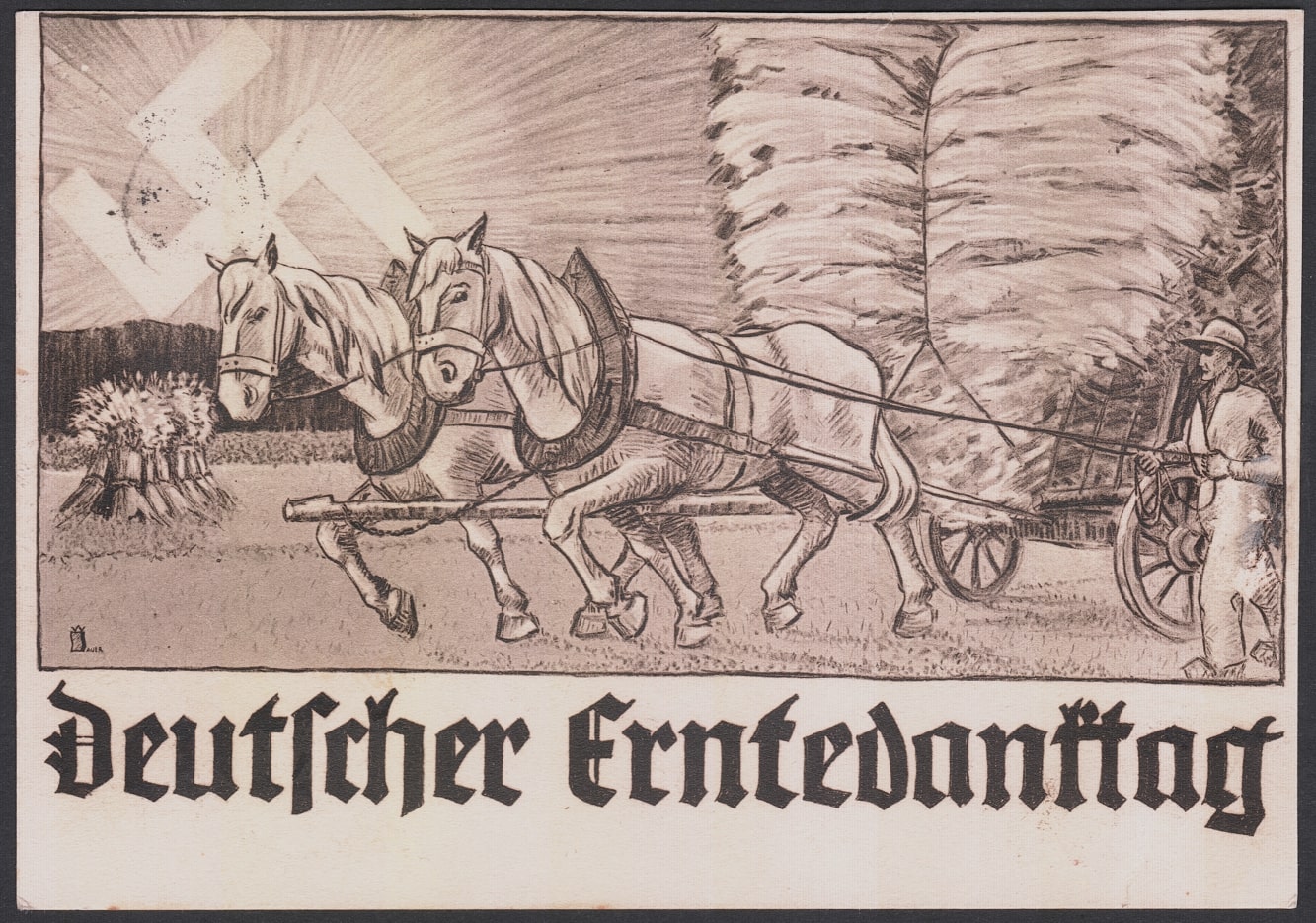
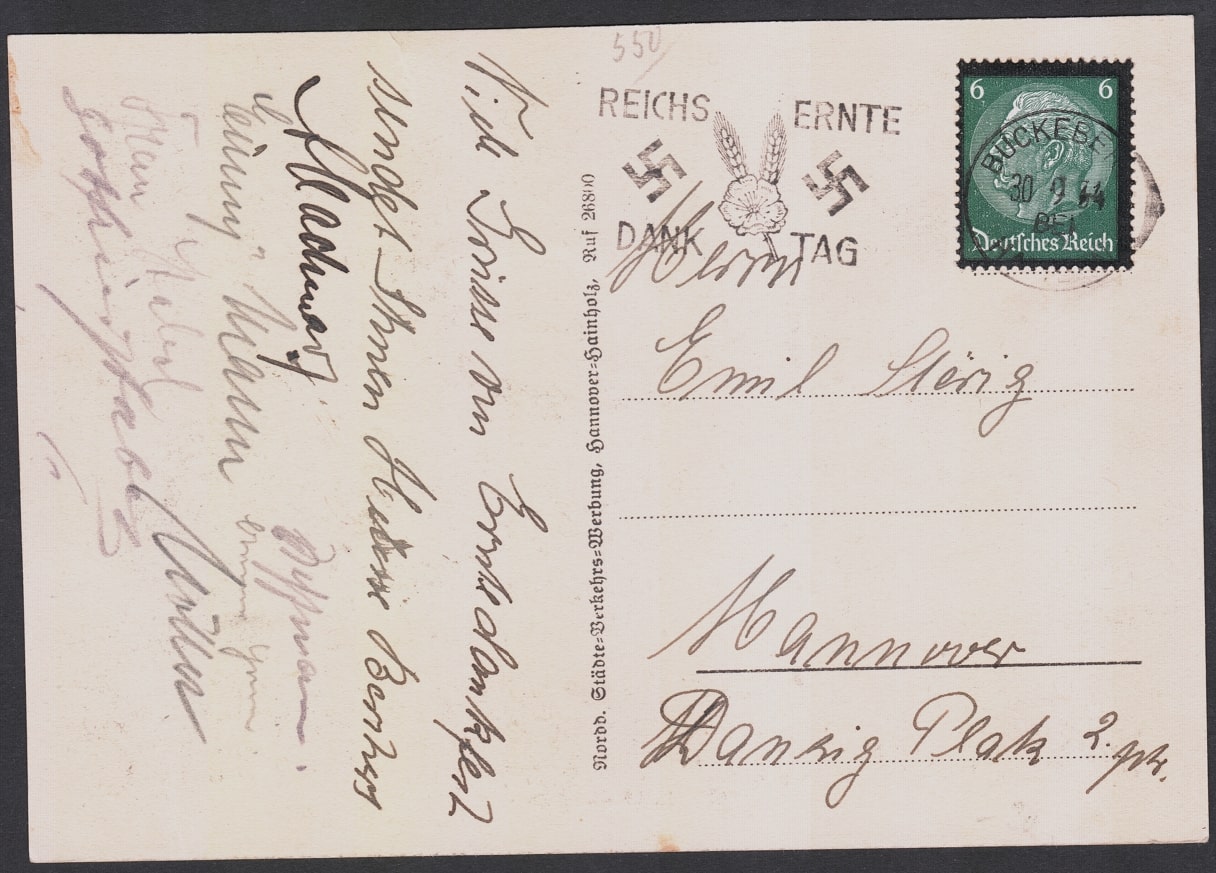
This post card was issued in 1934 to commemorate the annual harvest festival in Bueckeberg. It depicts two horses pulling a cart of straw while being guided by a farmer. In the background are more straw bales and a glowing swastika sun. This example was used and appears to have been sent from Hannover to Danzig.
Factory Workers (1934):
This postcard was issued in 1934 and was valid for use until the end of that same year. It features an illustration of factory workers carrying swastika flags and in the bottom right the words 'Nationaler Feiertag' or National Holiday in English. This example was postally used with the message being written on the 1st of May 1934 and then sent or at least postmarked the next day. It also features a handstamped message that reads 'vermeidet rundfunk störungen' or 'avoids radio interference' in English. It has a brief correspondence on the back of the card and it should be no surprise that it is entirely in German.
I've attempted to translate the writing and know that it begins with 'Liebes Muttchen!' or Dear Mummy/Mother in English, the writer explains that they've been busy and then (I think) that they feel sad today having just watched the 'Illamanation', potentially a mispelling of illumination. The writer gives their warm wishes and then signs off with the name Anna.
World Congress on Recreation Stamp and Cancel (1936):
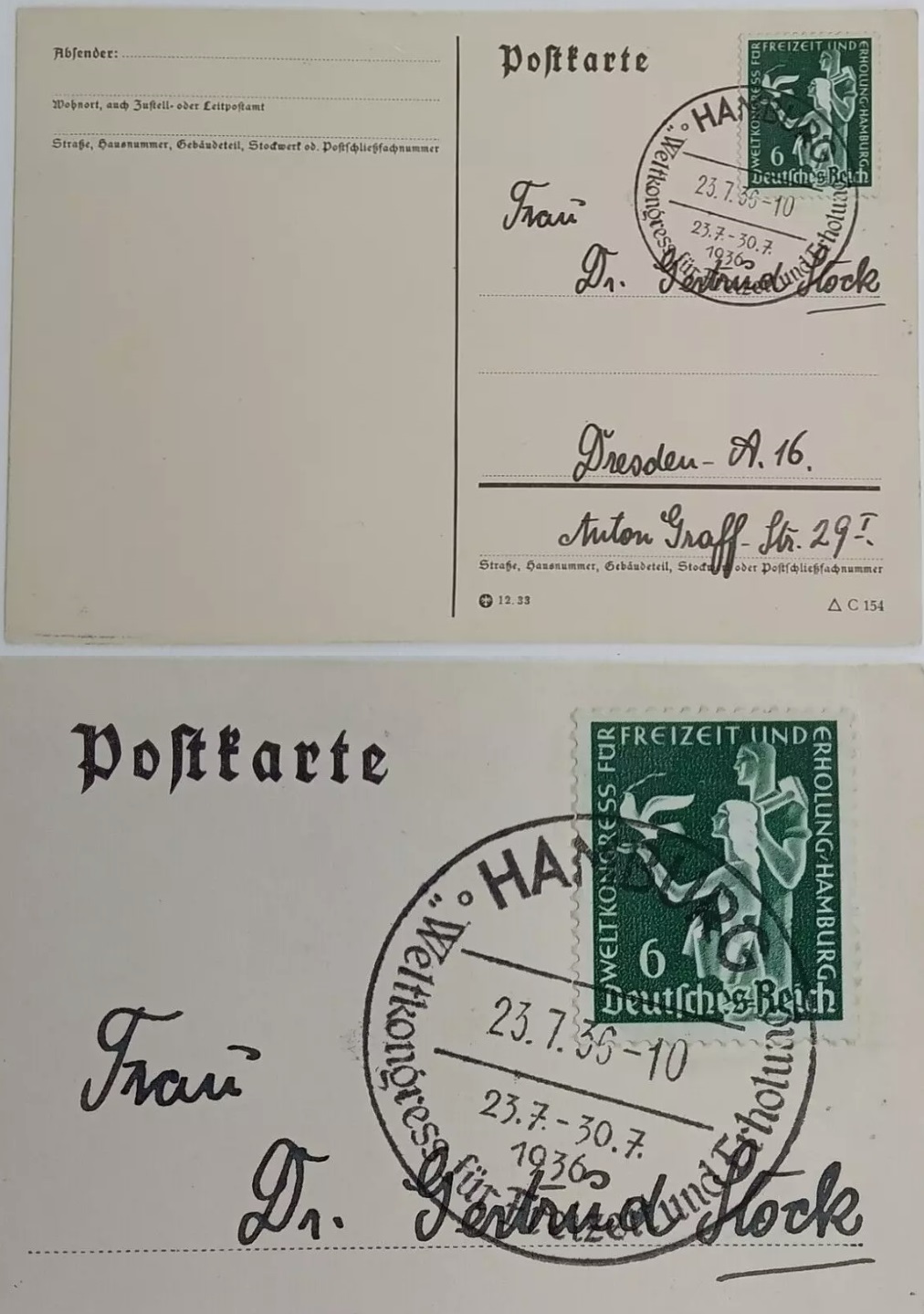
This postkarte and stamp are from 1936 with a Hamburg postmarke and being addressed to a residence in Dresden. It features a World Congress on Recreation stamp with catalog code Michel DR 622 and a cancel for the same congress. It is dated the 23rd of July 1936 with the stamp being first issued on the 30th June 1936.
NSKOV and the 1936 Olympics (1937):

This postcard features the Brandenburg gate of Berlin, a popular Nazi landmark, alongside an olympic arena. It bares the words 'Reichstreffen Der NSKOV Berlin' which represents the organisation of the 'Nationalsozialistische Kriegsopferversorgung' or The National Socialist War Victim's Care in English. An organisation created by the NSDAP to help seriously wounded veterans as well as the frontline fighters of world war one. In the top right is a light-brown 3 Pfennig Hindenburg medallion print.
This example was never postally used but bares a Berlin cancel from the 25th of August 1938.
Winterhilfswerk - Woman on a Production Line (1938):
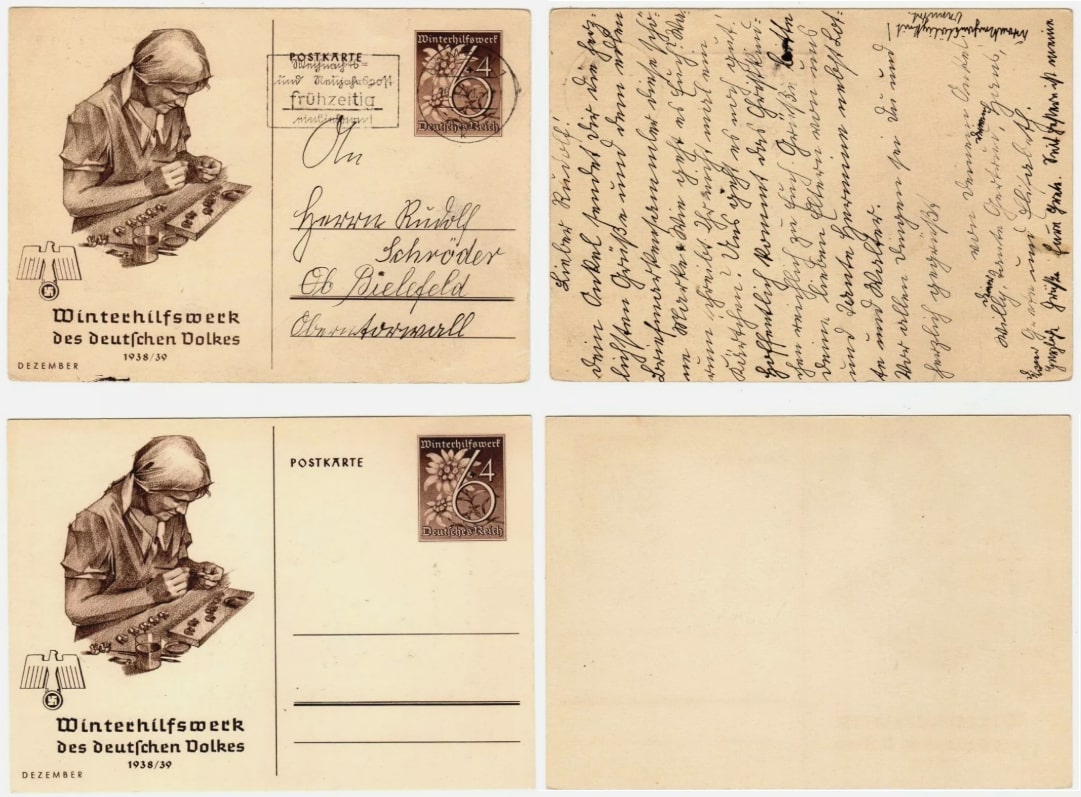
These two postcards were issued in 1938 for the National Socialist Peoples Welfare's (NSV) annual winter relief donation drive. It features a woman hard at work alongside the typical swastika adorned German eagle. These two examples represent both a postally used version and a post office fresh copy with the used postcard featuring a fairly lengthy message on the back. Proceeds from the 'Winterhilfswerk' donation drive supposedly went towards bettering the living conditions of struggling Germans. In reality the allocation of these funds was a lot less clear-cut with Martin Bormann going on to say that the funds raised by WHW were allocated and controlled by Adolf Hitler alone. It is likely a large quantity of these relief funds were used on armaments.
SA Reich Competitions in Berlin (1938):
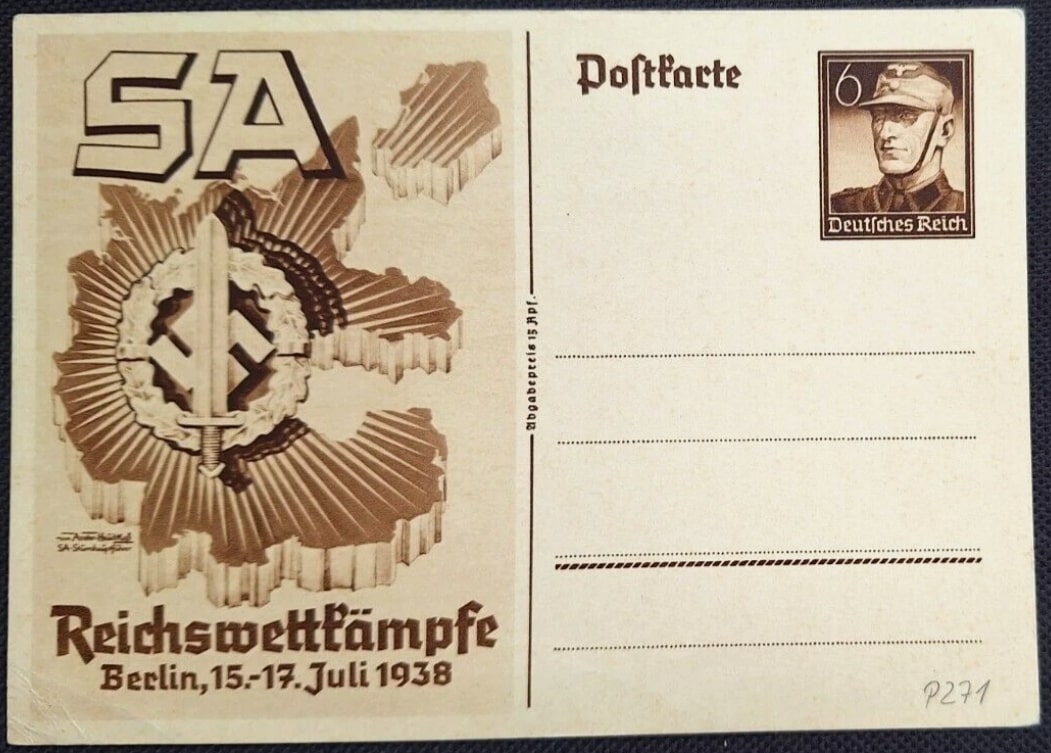
This postcard was issued on the 12th July 1938 to advertise for the Reich competitions of the SA to be held in Berlin. On the left are the bold letters 'SA' obviously standing for the Sturmabteilung. Below that is a map of greater Germany illuminated by a sword and swastika surrounded in an oak leaf laurel. Further down is the German word 'Reichswettkampfe' which translates to imperial competitions and also the dates of the 15th July to the 17th July 1938. It is an Ax-Heu illustration. The postcard also features an SA soldier in the top right with a 6 Pfennig value beside him.
My example was never cancelled or postally used but does have a minor crease in the bottom left corner. In pencil is it's catalog code.
Annexation of the Sudetenland (1938):
This postcard was issued on the 1st of October 1938 in Asch to commemorate the Nazi occupation of the City of Asch. This example was cancelled on the 30th September 1938 and has a Czechoslovakian stamp. It bares an additional special cancellation in red commemorating the annexation.
Adolf Hitler Portrait with Special 50th Birthday Cancel (1939):
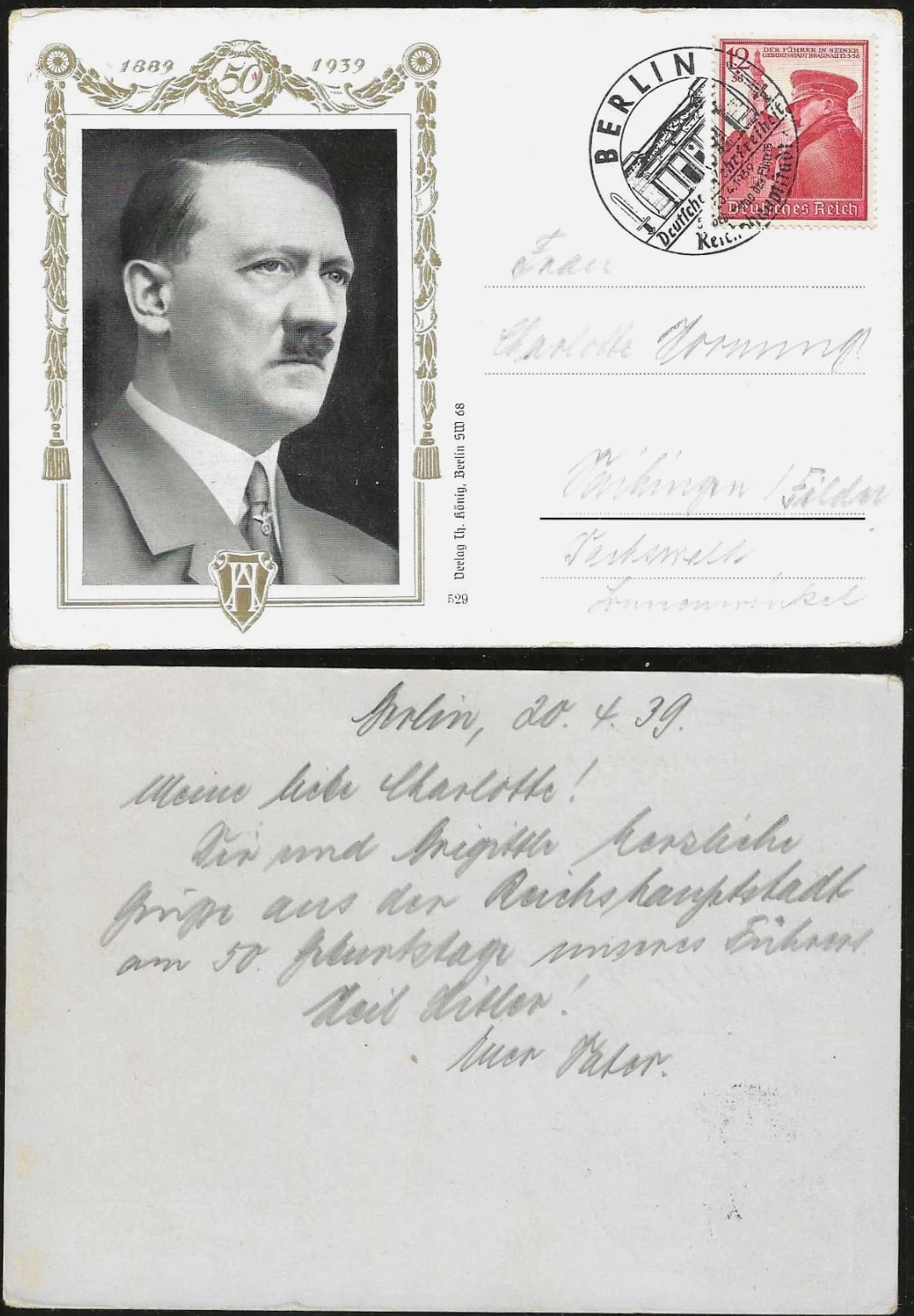
Here is a postkarte from 1939 commemorating the 50th birthday of Adolf Hitler. It shows a portrait of Hitler alongside his age of 50 and on either side of that the year of his birth and the present year. In the top right is a semi-postal stamp issued for his 50th birthday with a Michel catalogue code of DR 691 and face value of 12 + 38 Pfennig. It is cancelled with a unique Berlin postmark and of course dated the 20th April 1939. This copy was postally used and contains a brief correspondence on the backside of the postkarte. Overall it is in fair but used condition and one of many designs issued with Adolf Hitler's portrait.
International Automobile Exhibit Cancel (1939):
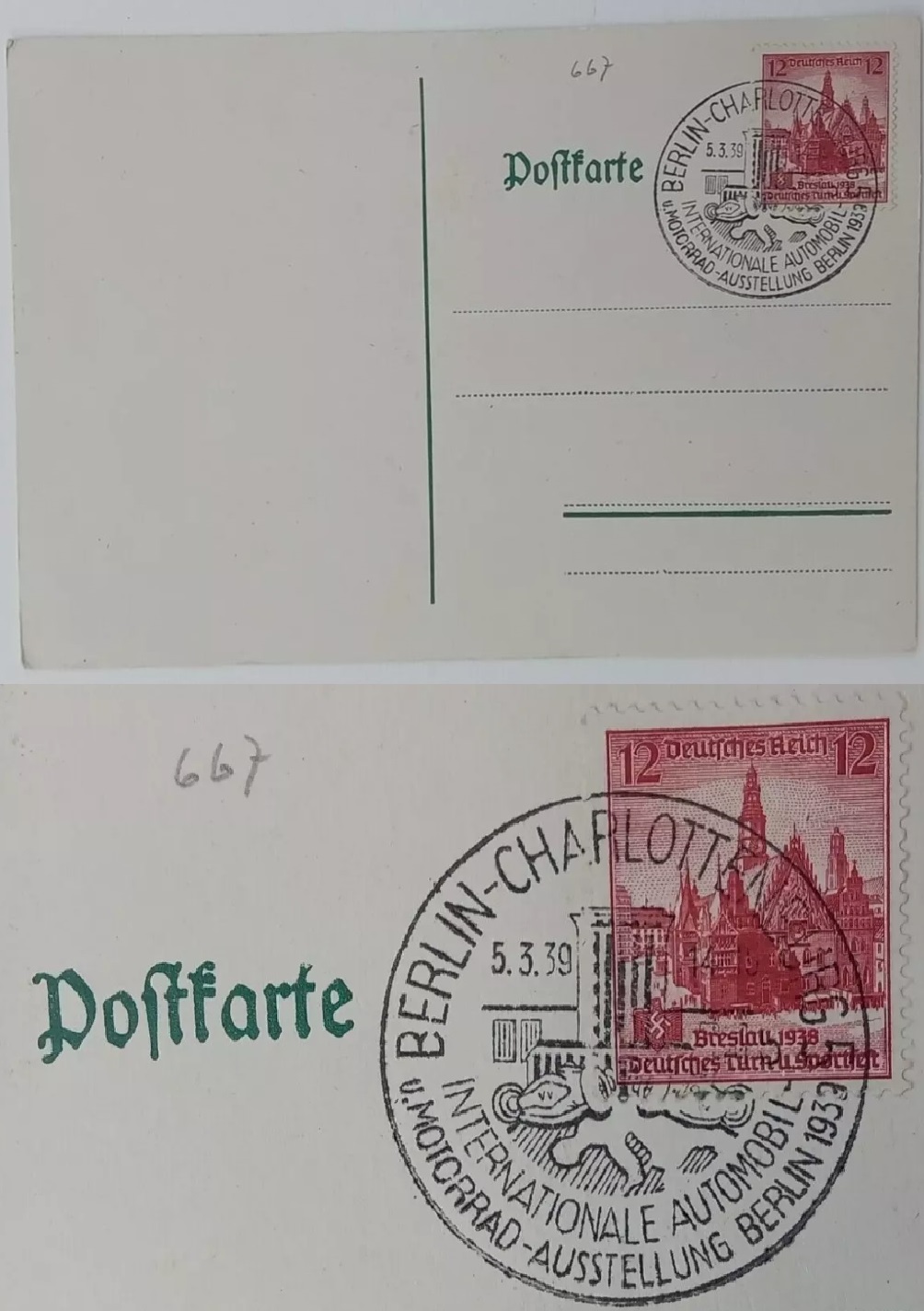
Here is a blank postkarte from 1939 with a cancel commemorating the 1939 International Automobile Exhibition atop a stamp first issued in 1938 for the German Gymnastics and Sports Festival. The cancel is dated the 5th March 1939 and is postmarked from the locality of Charlottenburg, Berlin. The stamp is Michel catalog code DR 667 (as you might have noticed on the postkarte), and has a face value of 12 Pfennig.
Winterhilfswerk Soldier and Worker (1940):
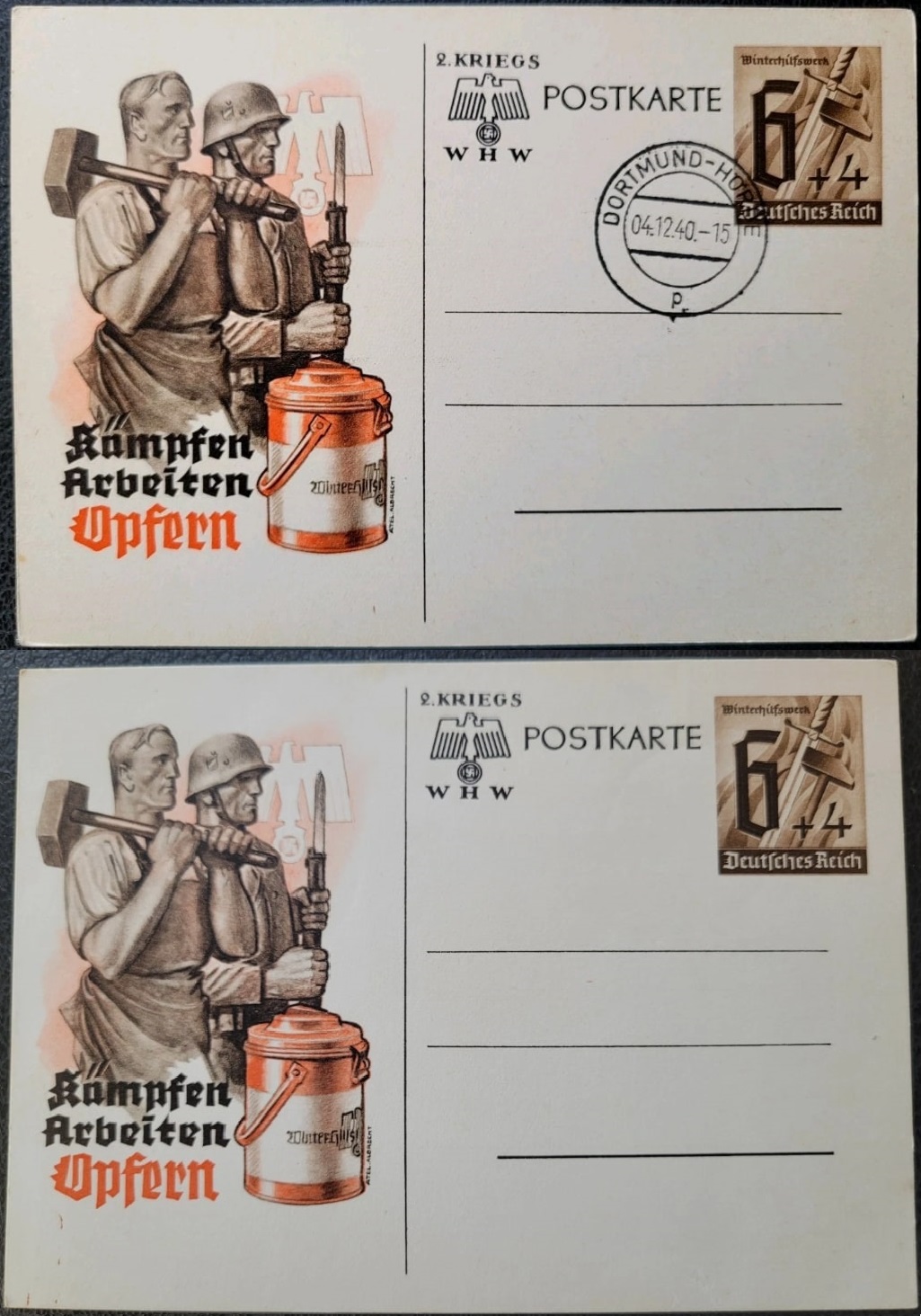
Here I have two examples of a postkarte I believe to have been issued in 1940. All sources I've found online say 1941 however my cancelled copy is dated December of 1940 and I can only conclude it was first printed right at the end of the year. Obviously I have both a cancelled and completely unused copy of this postkarte which features an armed soldier and a worker wielding a large hammer. In the background is the usual swastika perched German eagle and in the foreground a bright red donation tin with the word 'Winterhilfswerk' on the front (the Nazi's winter relief charity drive).
Written boldly in the bottom left are the words 'Kampfen Arbeiten Opfern' which translates to 'Fight. Work. Sacrifice.' In the top right is a sword and hammer with Winterhilfswerk written above it and a value of 6 + 4 Pfennig. The used example was cancelled in Dortmund but more specifically the city district or 'Stadtbezirk' of Hörde.
Ax-Heu Soldier with Banner (1941):

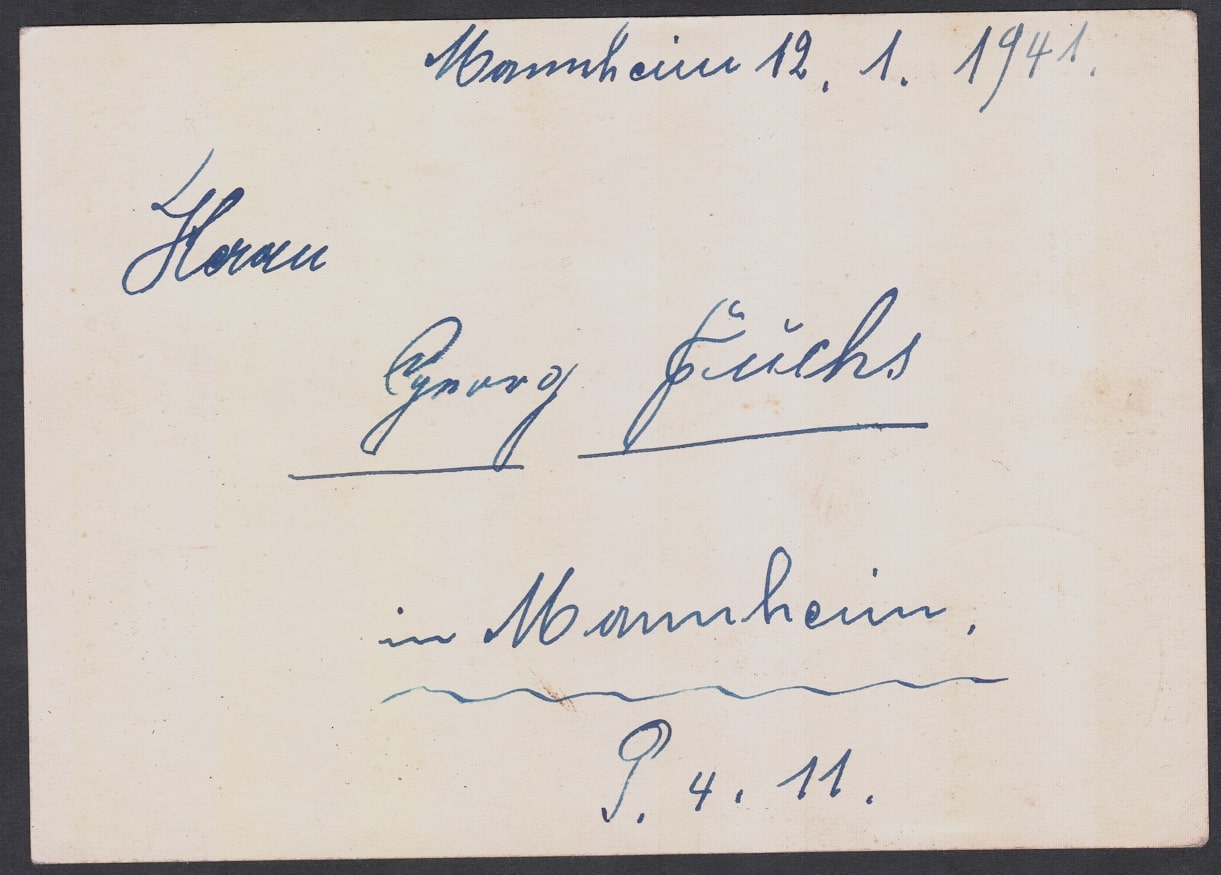
This postcard displays an Ax-Heu illustration drawn by the husband and wife team Axster-Heudtlass. Above it bares the words; Im Kampf um die Freitheit! Which translates to 'For the Battle of Freedom'. It was issued in 1941 as a Day of German Stamps KdF collector group postcard. This particular example was postmarked in Mannheim and features a greyish brown Winterhilfswerk stamp of Danzig with a face value of 3+2 Pfennig, with the stamp being first issued on the 5th of November 1940.
Ax-Heu Railway Artillery (1941):
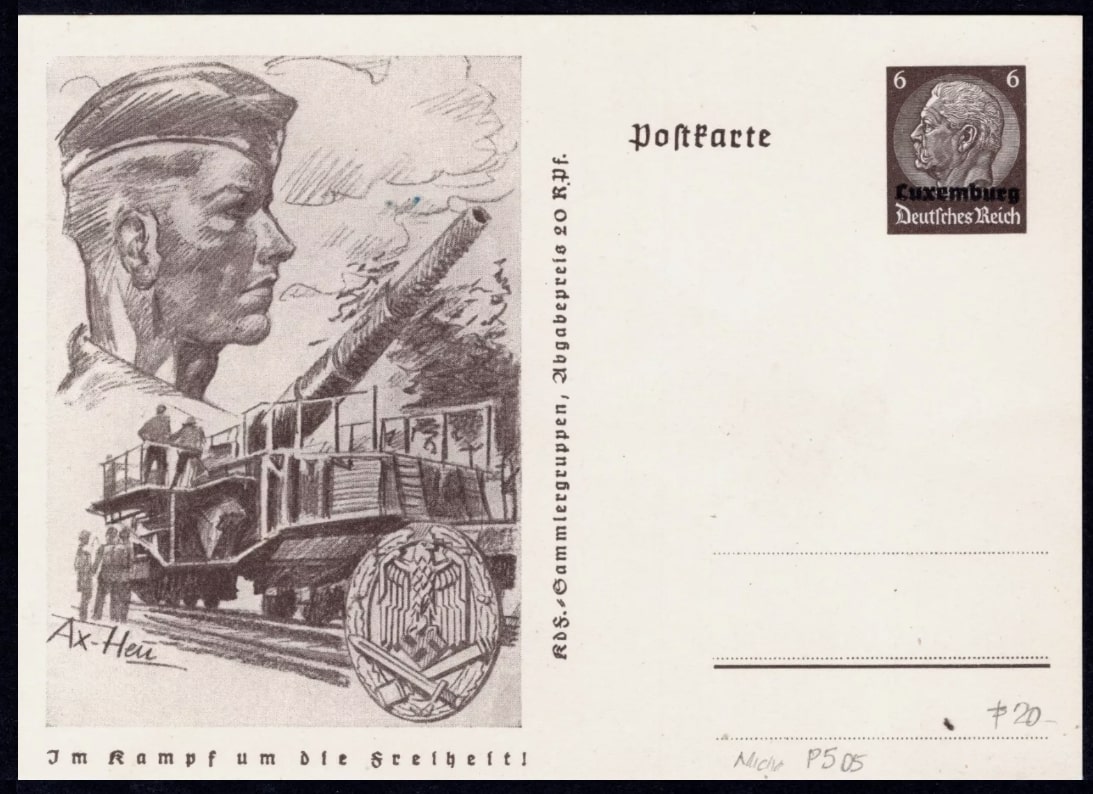
This postcard was issued to commemorate Stamp Day on the 12th of January 1941. It is part of a series of eight postcards adorned with the words 'Im Kampf un die Freiheit', which translates to 'In Struggle and Freedom'. The whole series of eight postcards were designed by the husband and wife team of illustrators Axster-Heudtlass and display different branches of the German armed forces. This card in particular shows railway artillery and is the fifth in the series. It features a 6 Pfennig Hindenburg medallion print with a 'Luxemburg' occupation overprint. This postcard was never used and in pencil is it's catalog code and presumably old catalog value.
Ax-Heu Stamp Day Feldpost-karte with Special Cancel (1942):
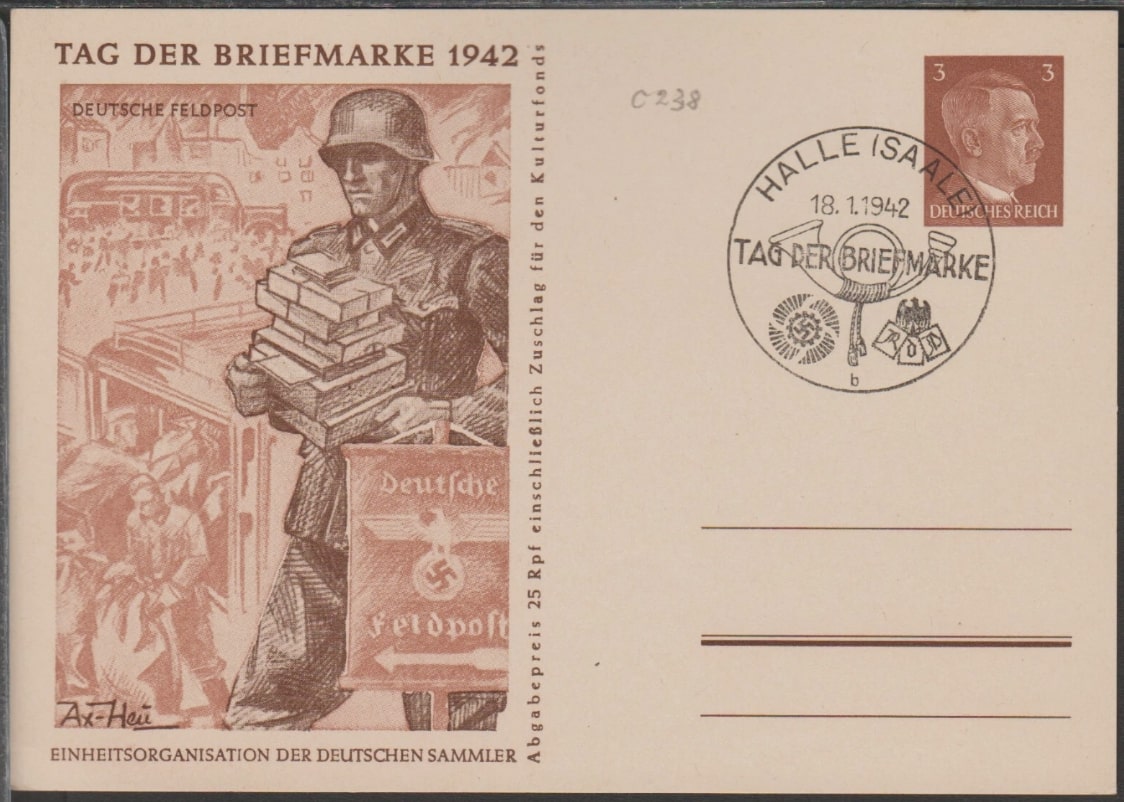
This postcard was issued to commemorate Stamp Day or 'Tag der Briefmarke' in 1942 and features a soldier carrying mail alongside a banner that says Deutsche Feldpost. In the background are other soldiers loading mail into the back of vans and below the whole illustration are the words 'Einheitsorganisation Der Deutschen Sammler' which translates to 'Unified Organization of German Collectors'. Running all alongside the right of the illustration are the words: 'Abgabepreis 25 rpf einschlieblich zuschlag fur den kulturfonds' and this in English translates to: 'Selling price of 25 rpf including surcharge for the cultural fund'
This postkarte is postally unused but features a special commemorative cancel for stamp day from Halle which is dated the 18th of January 1942. And of course in the top right is a brown 3 Pfennig Adolf Hitler print.
First Postage Stamp Exhibition of Litzmannstadt (1942):

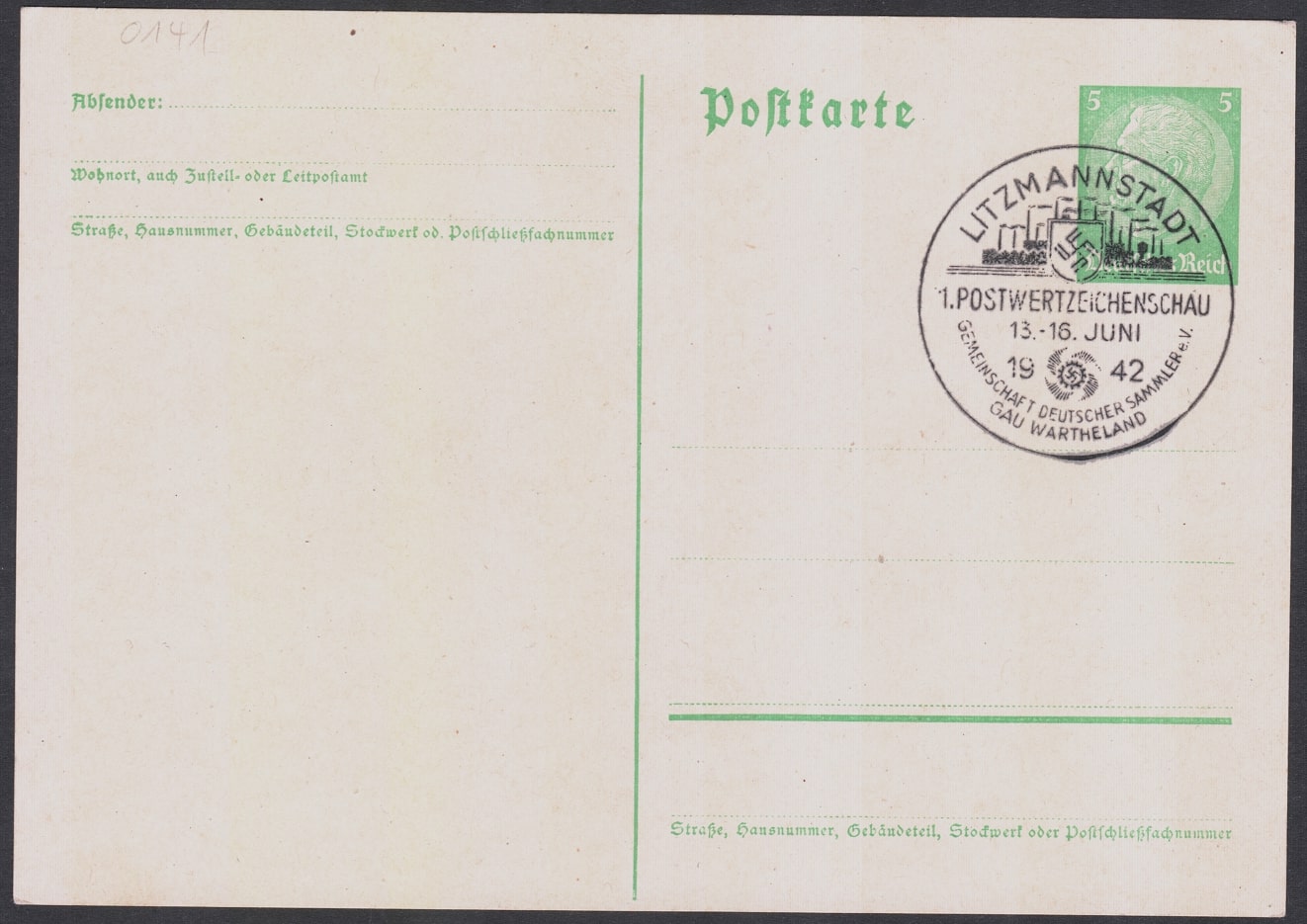
This postcard was issued for the first postage stamp exhibition held in Litzmannstadt from the 13th to 16th of June 1942. Indeed 'Postwertzeichenschau' translates to postage stamp show in English. The phrase of the left hand side 'Gemenschaft Deutscher Sammler' translates to the community of German collectors. This event took place during the Nazi occupation of Poland and Litzmannstadt was the German moniker for the occupied city of Lodz in Poland. The exhibition also occured during the operation of the Lodz Ghetto, the second largest ghetto in German-occupied Europe. The image portrays an expanse of factories, many with billowing chimneys. This was likely an attempt to obscure the reality of the Ghetto and to mislead the German public into believing it was only an industrial compound. The imagery in hindsight is disturbing to say the least.
This example was never sent postally but has the Litzmannstadt exhibition cancel on the back atop a green 5 Pfennig Hindenburg medallion print.
German Association of Goldsmiths (1942):
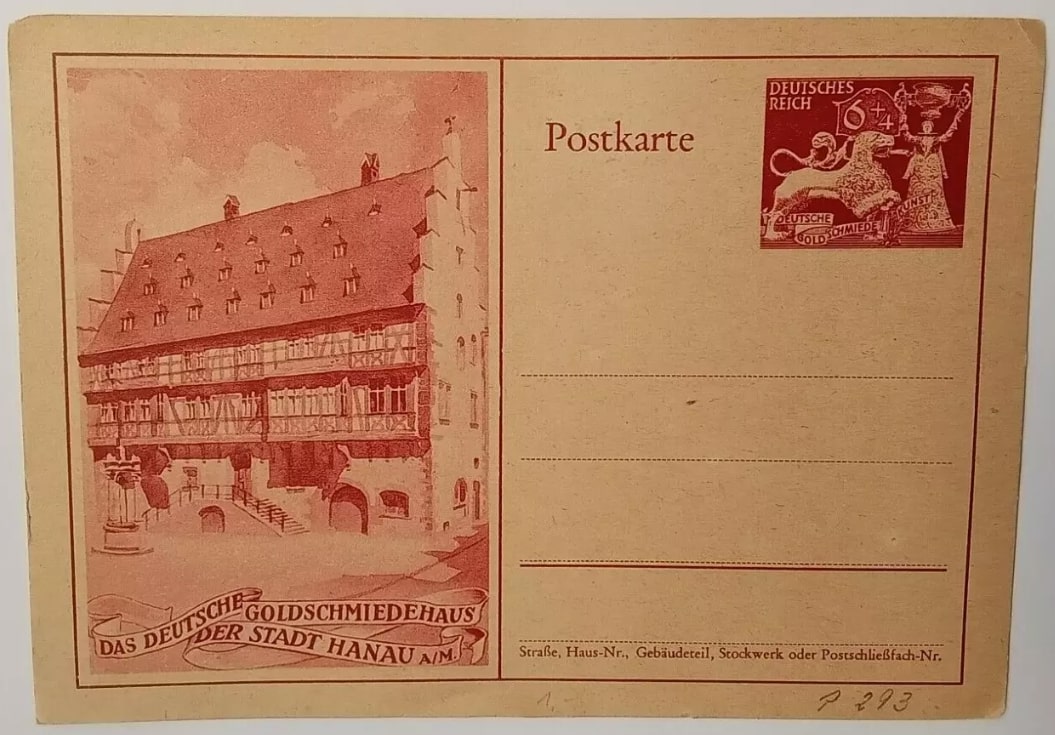
Here is a blank and never postally used postkarte issued to honour the German Association of Goldsmiths. It is one of many philatelic items issued to honour the association and in the uppermost right corner features a print of a stamp from 1942 intended to do just that. This copy is in fairly yellowed and worn condition but is still perfectly legible and in my mind worth preserving.
German Association of Goldsmiths (1943):
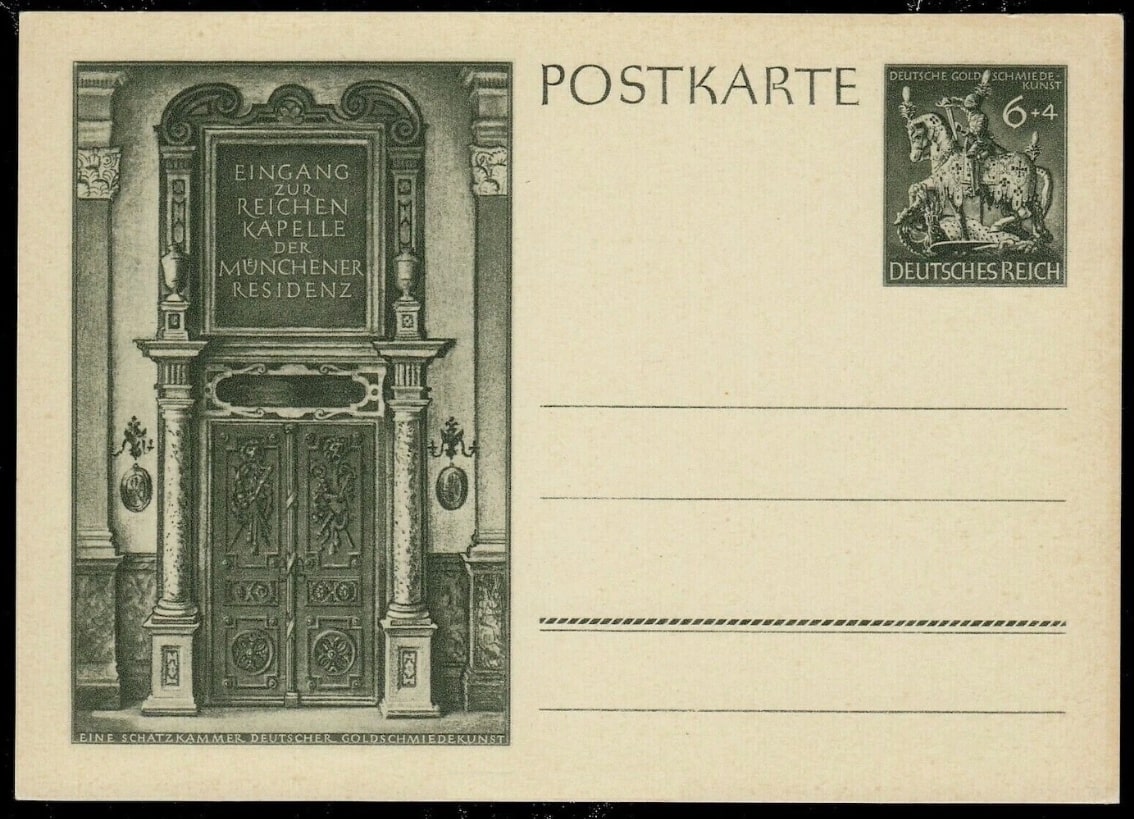
Here is a blank and never postally used postkarte issued to honour the German Association of Goldsmiths. It is one of many philatelic items issued to honour the association and in the uppermost right corner features a print of a stamp from 1943 intended to do just that. This copy is in very fine condition. It depicts an ornate doorway with the words 'Eingang Zur Reichen Kapelle Der Munchener Residenz' which translates (perhaps poorly) to 'Entrance to the Rich Chapel of the Munich Residence'. In the bottom of the illustration are the words 'Eine Schatzkammer Deutscher Goldschmiedekunst' which translates to 'A Treasure Trove of German Goldsmithing'. It features my personal favourite stamp issued by the Reich to commemorate the German Goldsmiths Association. It depicts a knight adorned in golden armour atop a weakened dragon and has a face value of 6 + 4 Pfennig.
Adolf Hitler's Fifty-Fifth Birthday - First Day Cancels (1944)
Amsterdam Cancel:
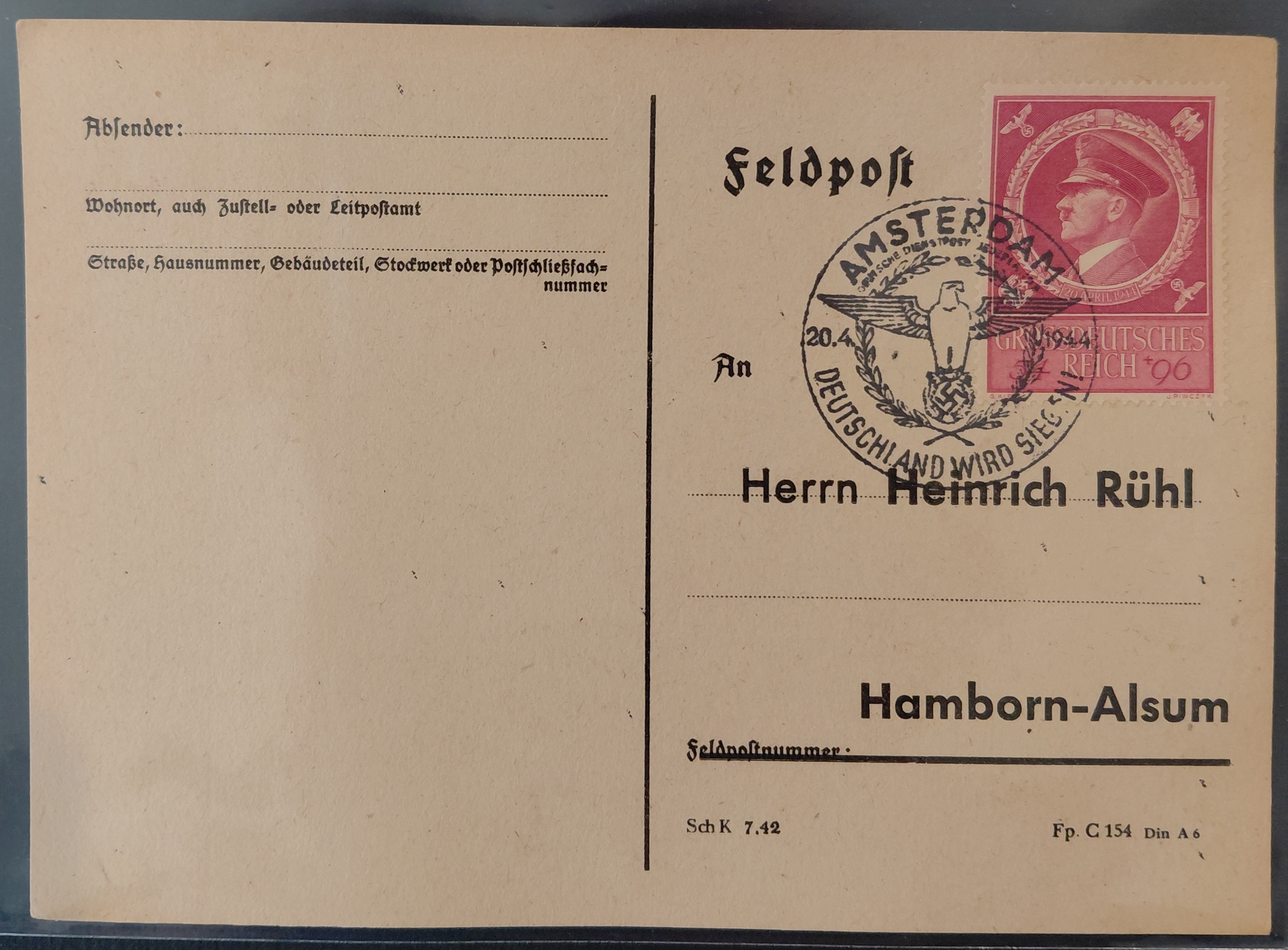
Featured is one of my collection of five postkartes issued with a stamp commemorating Adolf Hitler's 55th Birthday and cancelled on the first day of issue. This example was postmarked in Amsterdam on the 20th April 1944 with a cancel featuring the swastika perched German eagle and the words 'Deutschland Wird Siegen!' which translates to 'Germany will win!', obviously referring to the war effort. This example is on a feldpost card with the stamp being in very good condition and the postmark clearly legible.
Berlin Cancel:
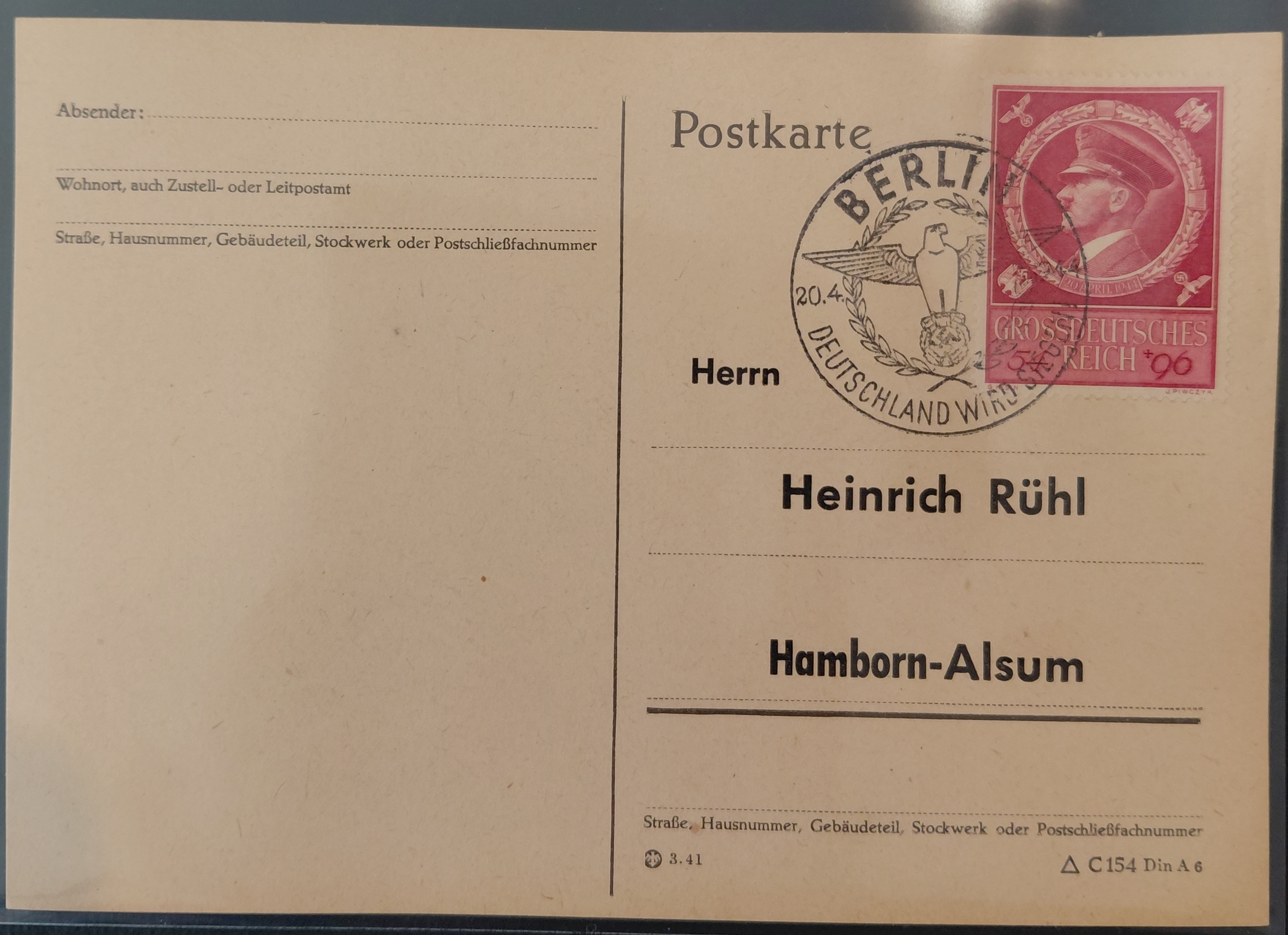
Featured is one of my collection of five postkartes issued with a stamp commemorating Adolf Hitler's 55th Birthday and cancelled on the first day of issue. This example was postmarked in Berlin on the 20th April 1944 with a cancel featuring the swastika perched German eagle and the words 'Deutschland Wird Siegen!' which translates to 'Germany will win!', obviously referring to the war effort. This example is on a standard postkarte with the stamp being in very good condition and the cancel clearly legible.
Braunau am Inn Cancel:
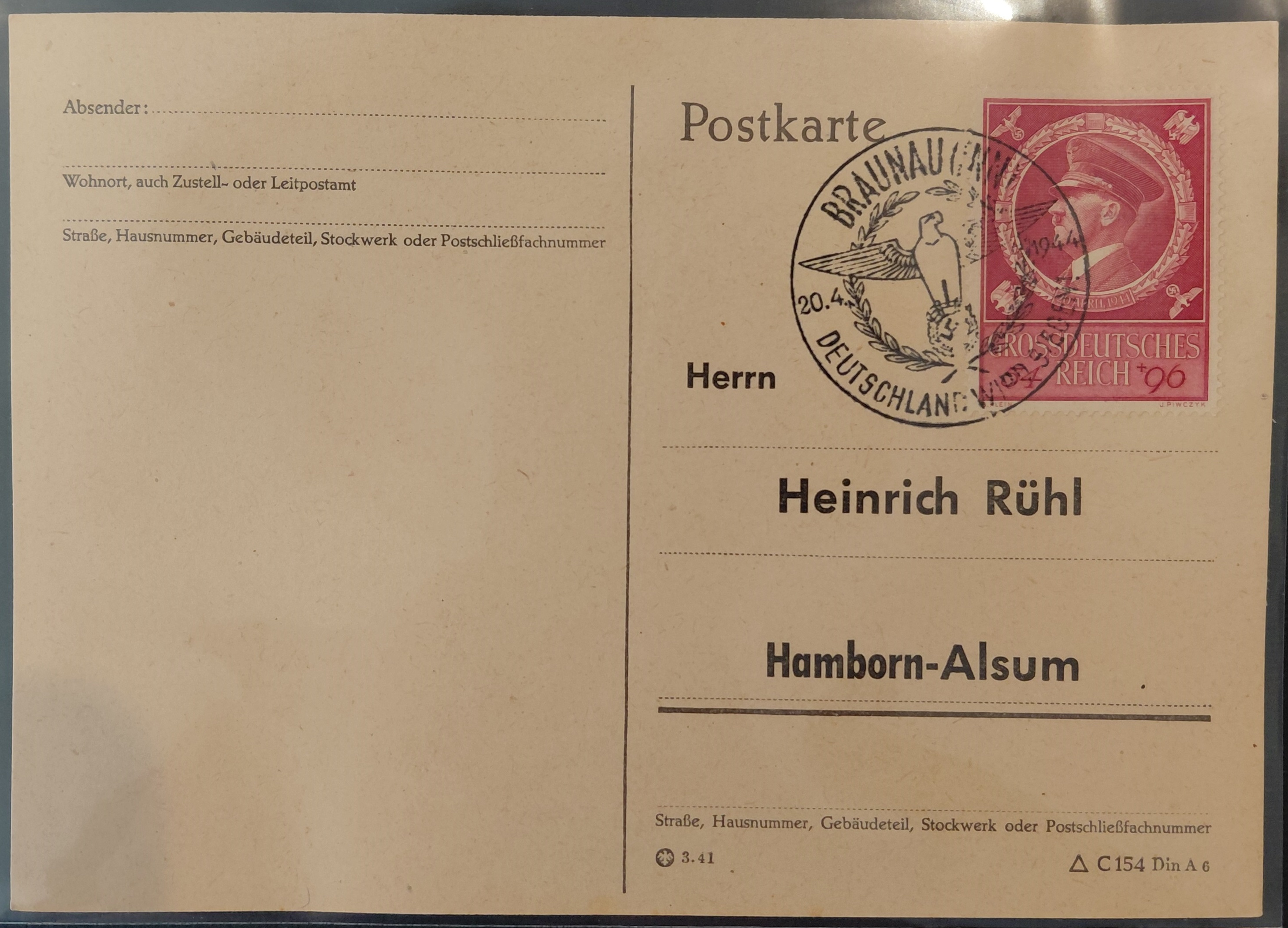
Featured is one of my collection of five postkartes issued with a stamp commemorating Adolf Hitler's 55th Birthday and cancelled on the first day of issue. This example was postmarked in Braunau am Inn on the 20th April 1944 with a cancel featuring the swastika perched German eagle and the words 'Deutschland Wird Siegen!' which translates to 'Germany will win!', obviously referring to the war effort. This example is on a standard postkarte with the stamp being in very good condition and the cancel clearly legible. Braunau am Inn is a relatively small town in Austria that borders with Germany and is the birthplace of Adolf Hitler.
Nuremberg Cancel:
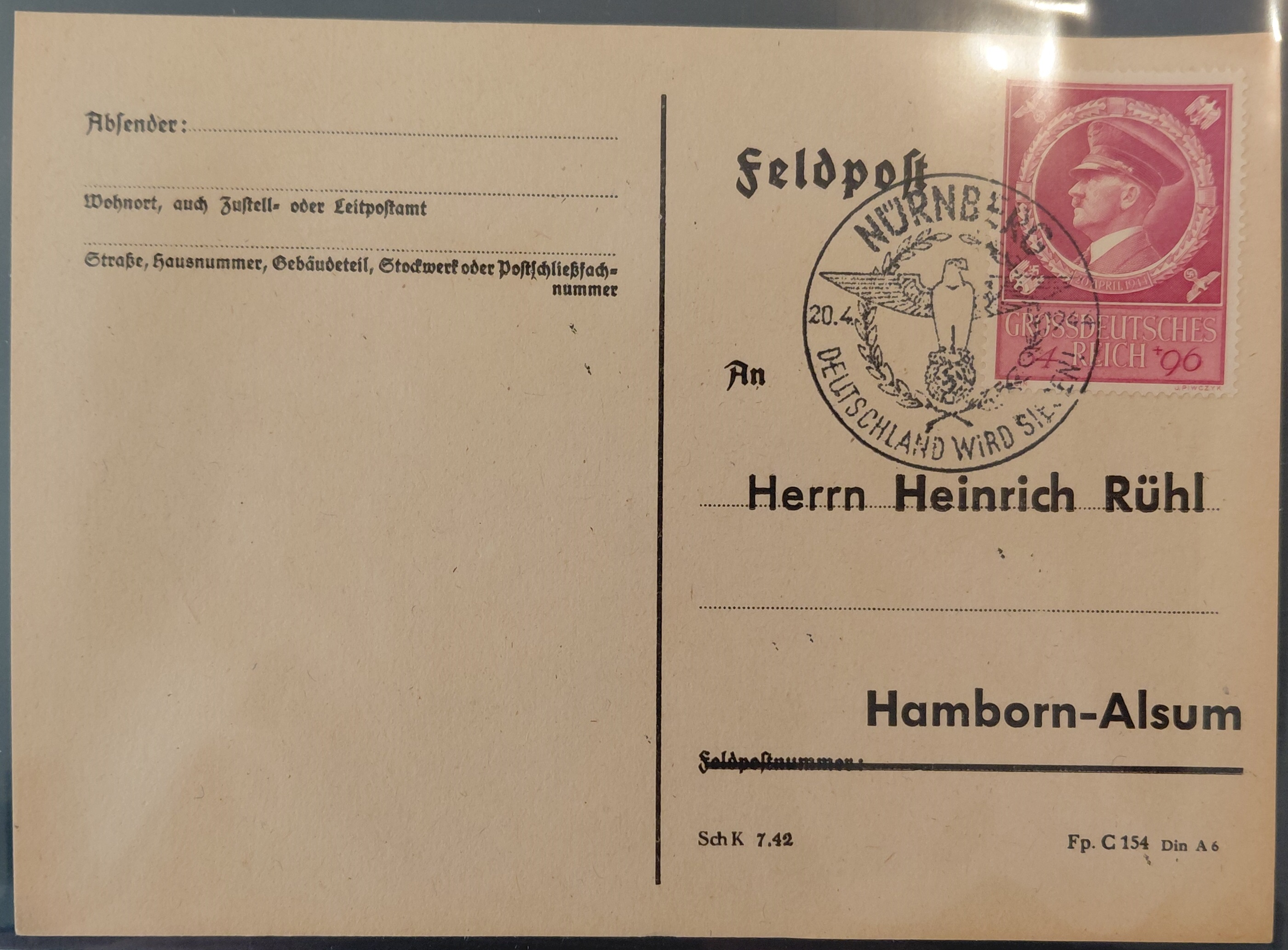
Featured is one of my collection of five postkartes issued with a stamp commemorating Adolf Hitler's 55th Birthday and cancelled on the first day of issue. This example was postmarked in Braunau am Inn on the 20th April 1944 with a cancel featuring the swastika perched German eagle and the words 'Deutschland Wird Siegen!' which translates to 'Germany will win!', obviously referring to the war effort. This example is on a feldpost card with the stamp being in very good condition and the cancel clearly legible.
Vienna Cancel:
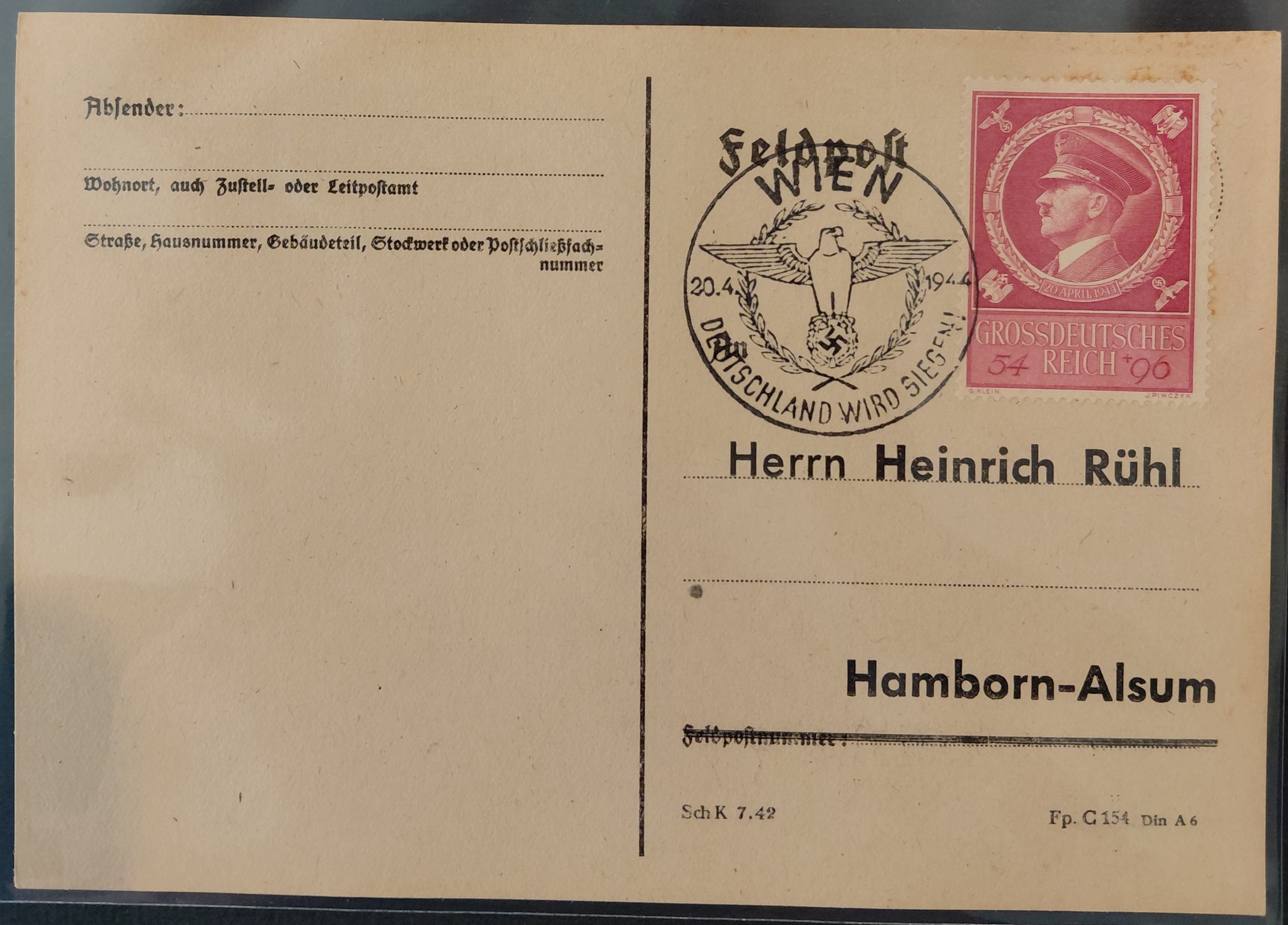
Featured is one of my collection of five postkartes issued with a stamp commemorating Adolf Hitler's 55th Birthday and cancelled on the first day of issue. This example was postmarked in Vienna on the 20th April 1944 with a cancel featuring the swastika perched German eagle and the words 'Deutschland Wird Siegen!' which translates to 'Germany will win!', obviously referring to the war effort. This example is on a feldpost card with the stamp being in very good condition and the cancel clearly legible.
Series of Occupation Postkartes (Various):
Ostland Occupation Postkarte:
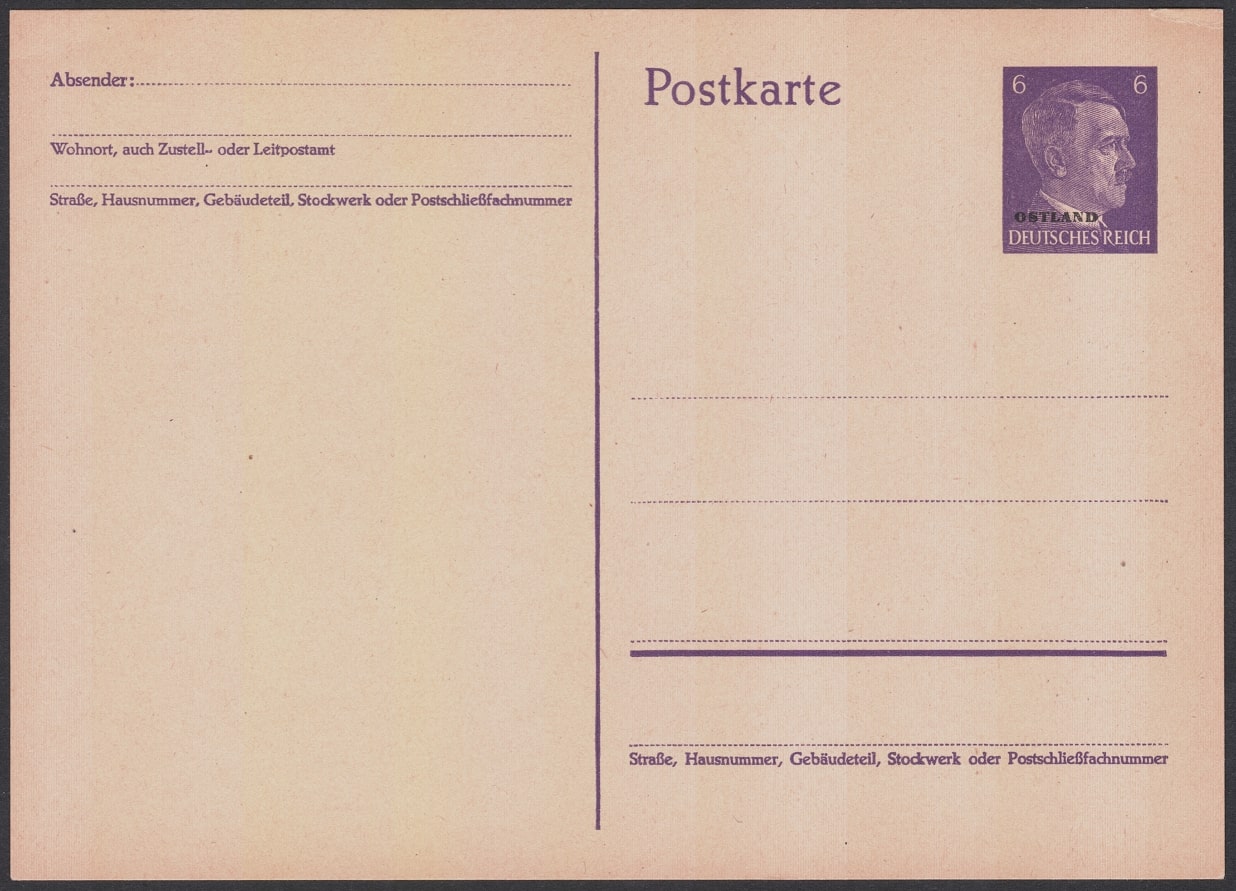
Here is an example of a plain and unused postkarte with an Ostland occupation overprint. It is overprinted on a 6 Pfennig purple Hitler portrait. The Reichskommissariat Ostland was an administrative entity of the Reich Ministry for the Occupied Eastern Territories of Nazi Germany from 1941 to 1945. It comprised parts of what is today Belarus, Estonia, Latvia, Lithuania and Russia.
Lothringen Occupation Postkarte:
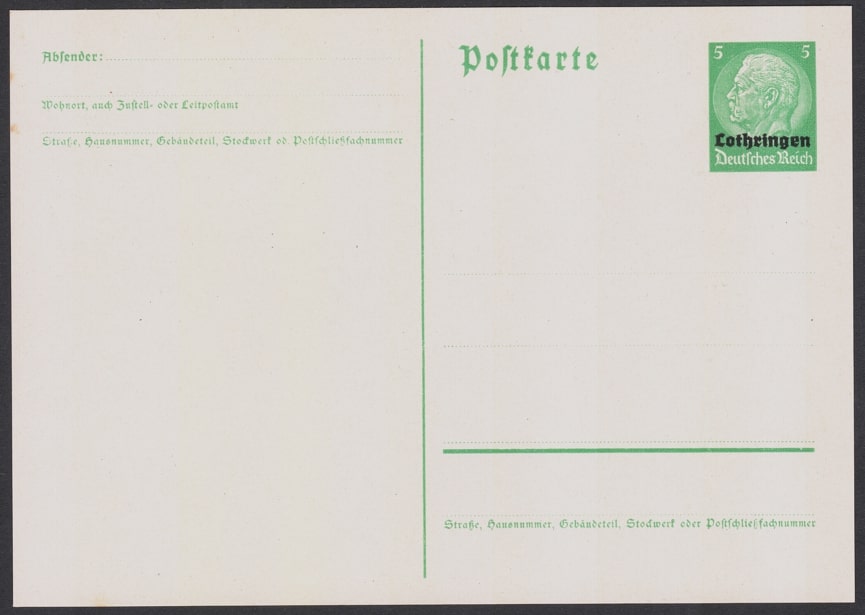
Here is an example of a plain and unused postkarte with a Lothringen occupation overprint. It is overprinted on a 5 Pfennig emerald green Hindenburg portrait. This was an occupation of the Alsace-Lorraine region of France during World War II.
Alsace Occupation Postkartes:
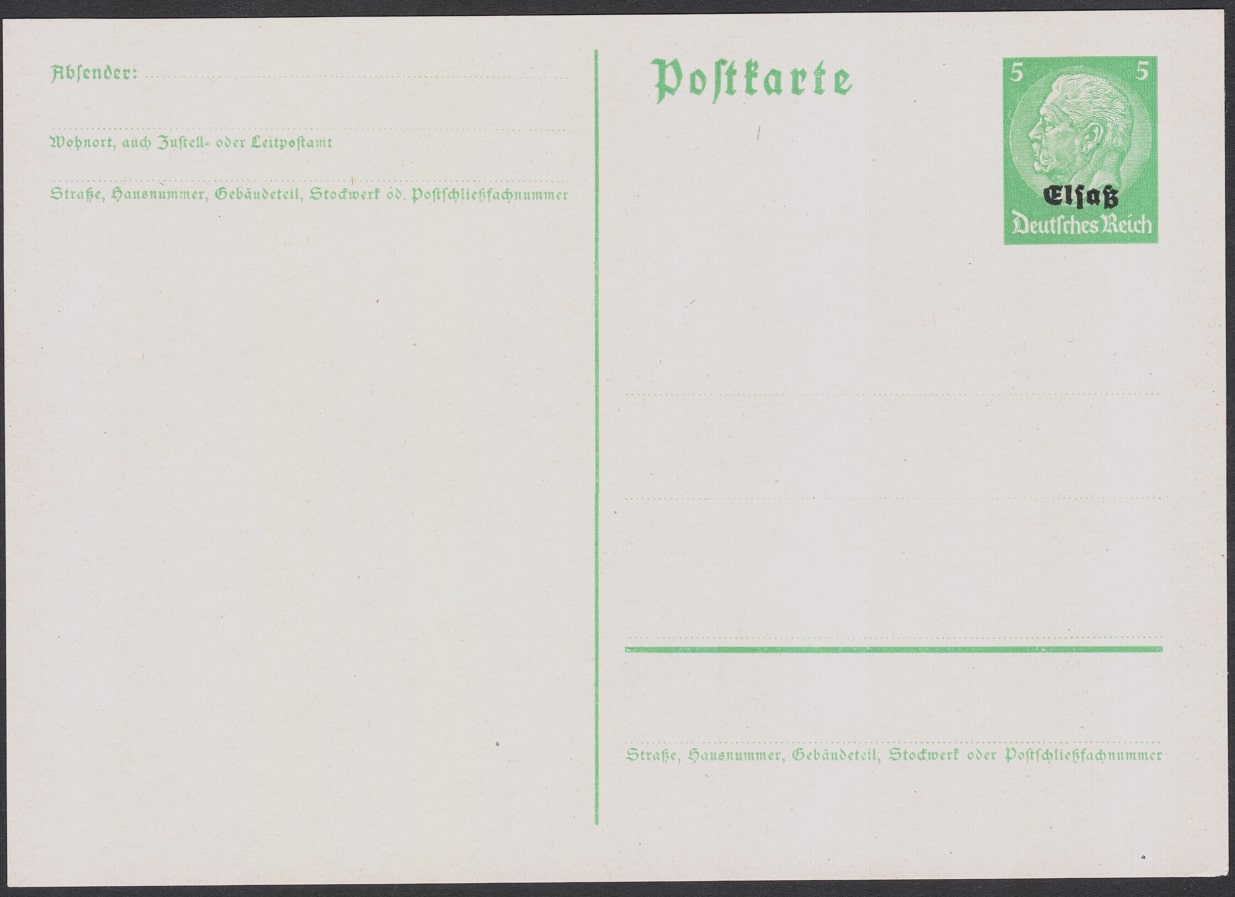
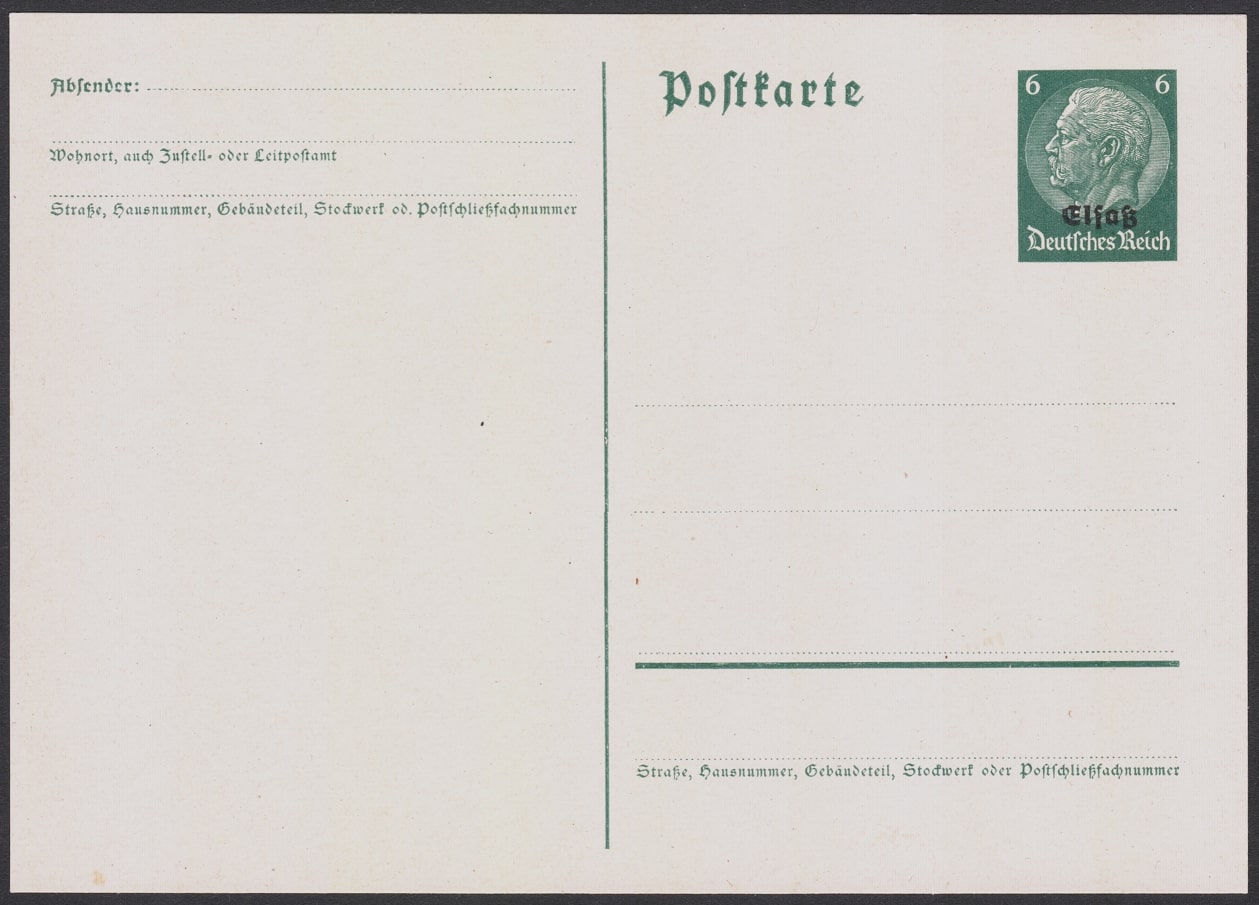
Here are two examples of plain and unused postkartes with 'Elfab' occupation overprints. The uppermost being cancelled on a 5 Pfennig emerald green Hindenburg and the other on a 6 Pfennig dark green Hindenburg. Stamps and postkartes overprinted with 'Elfab' during World War II were done so under the German occupation of Alsace-Lorraine in France.